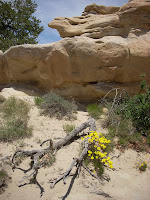Last Week in the Cibola
A recap of Team 5's trip to the Cibola National Forest, thanks to team member Mary Twenter:
New Mexico Team 5 thought of a few clever team names... the "Mojitos" or "Will Hike For El Bruno's Food," but in the end, we really ended up as the New Mexico Five, a team that worked together.
Our trip was well supported by local trail fans and began at, where else, El Bruno's pouring over maps and enjoying dinner with Dr. Dick Kozoll and his wife who have been working diligently with a local trail team on maintaining and improving the trail in the Cuba area. Dr. Kozoll pointed out several places where we would find the trail to deviate from the maps we were provided and assured us the stretch under their care was well marked.
The first day out began on a slippery slope of Mesa Chivato in the Cibola National Forest. Abundant rain made the road to the trailhead impassable so we had to HIKE... Our stretch of the trail would take us basically up and over four mesas in 55 miles or so.
Experiencing the environments up close drove home how important it is to get out and learn from the great outdoors - all these mesas look the same from the car!
Our local shuttle driver, Bill Leverton, is the publisher of the Cuba Area Visitor Guide and described the Cuba landscape as, "an area of grasslands, deep, deep washes, high mesas, fantastical rock and sandstone formations and battalions of geologic weirdness" in his December 2006 edition. We agree!
Fortunately, the trail on our section was wonderfully marked with cairns and posts almost 100 percent of the way. We were able to enjoy the scenery because of the awesome work of CDT trail-tenders.
One item of importance for teams to follow: logon to the CDT blogs of regular and thru-hikers to check on issues arising on your section of the trail. We had a wonderful contact from BLM who gave us great tips on our section and knew the trail well but was unaware that a water spigot we were counting on was not operational. He thought it was. Thru-hikers we met knew it wasn't and had planned accordingly. We hadn't.
Thank goodness Dr. Kozoll makes trail calls and delivered water to our camp. Water is the chief concern on this section. The springs we used on either side of the spigot were good sources and well spaced along the trail.















